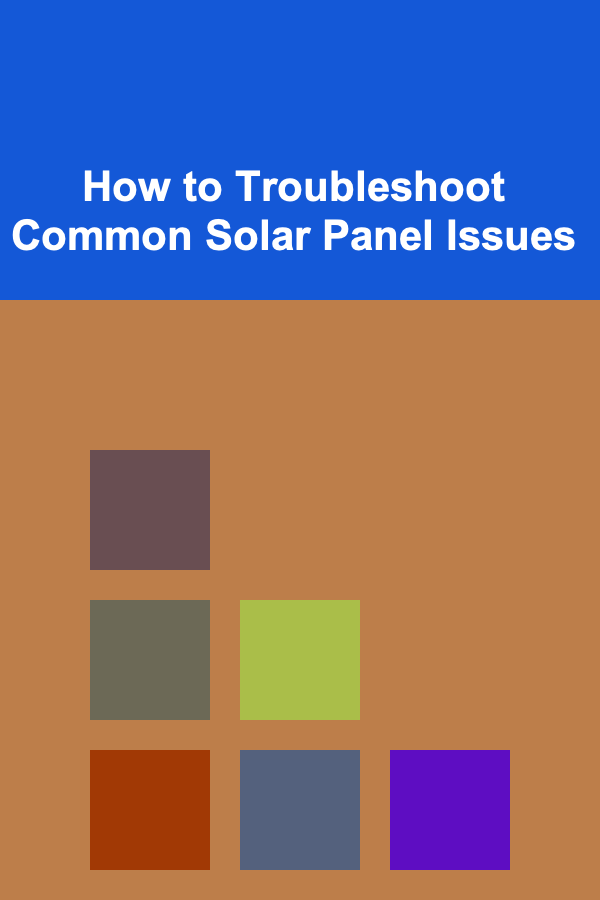
How to Troubleshoot Common Solar Panel Issues
ebook include PDF & Audio bundle (Micro Guide)
$12.99$6.99
Limited Time Offer! Order within the next:

Solar panels are becoming increasingly popular as a sustainable energy solution. They offer a reliable source of energy, lower utility bills, and contribute to reducing the carbon footprint. However, like all systems, solar panels are not immune to issues. Troubleshooting these problems promptly can ensure the system runs efficiently, prolong the lifespan of the panels, and avoid costly repairs. In this article, we will explore common solar panel issues, how to identify them, and the steps you can take to troubleshoot and resolve these problems.
Understanding How Solar Panels Work
Before diving into troubleshooting, it's essential to understand how solar panels function. Solar panels convert sunlight into electricity using photovoltaic (PV) cells. These cells are made of semiconductor materials (usually silicon), which generate direct current (DC) electricity when exposed to sunlight. An inverter then converts the DC electricity into alternating current (AC), which is the form used by most household appliances.
A well-maintained solar panel system will generate power efficiently as long as there is sunlight. However, several issues can arise over time that can affect performance.
Low or No Power Generation
One of the most common problems that solar panel owners experience is low or no power generation. This can be caused by a variety of factors, including shading, dirt, and faulty components. Here are the main reasons and how to troubleshoot them.
Shading
Solar panels rely on sunlight to generate electricity. If something blocks the sunlight, such as trees, buildings, or even dust, the system's efficiency will be compromised. The shading can significantly reduce the power output, especially if it occurs during peak sunlight hours.
Troubleshooting Steps:
- Inspect the Panels: Check for any obstructions or shade cast on the panels. Look for trees, branches, or other objects that might be blocking sunlight.
- Trim Trees or Move Objects: If shading is caused by overgrown trees or nearby objects, trim or move them to ensure that the panels receive maximum sunlight.
- Use Monitoring Software: Many solar panel systems come with monitoring software or apps that can help you track the power output in real time. Check the system's performance to see if the shading is affecting the power generation.
Dirt and Debris
Solar panels are often exposed to dust, dirt, bird droppings, and other debris, especially in dry or windy areas. This build-up can block sunlight and reduce efficiency. While panels are designed to be durable and weather-resistant, dirt accumulation is a common issue.
Troubleshooting Steps:
- Clean the Panels: Use a soft brush, cloth, or specialized solar panel cleaner to gently remove dirt and debris. Avoid harsh chemicals that could damage the panels.
- Check the Angle: Ensure that the angle of your panels is optimal for sunlight exposure. Panels that are too flat or improperly angled might collect more dirt.
- Regular Maintenance: Establish a routine for cleaning your panels to prevent dirt build-up. This is particularly important in areas with frequent dust storms or bird activity.
Faulty Inverter
The inverter is responsible for converting the DC electricity generated by the panels into AC electricity. If the inverter malfunctions, your system will not generate usable power, even if the panels are working correctly. Inverters have indicator lights that show the status of the system, and most models provide error codes for troubleshooting.
Troubleshooting Steps:
- Check the Inverter Display: Many inverters have an LCD screen or indicator lights that display the system's status. Look for any error codes or abnormal displays.
- Reset the Inverter: Sometimes, simply resetting the inverter can resolve minor issues. Follow the manufacturer's instructions to reset the unit.
- Contact the Manufacturer: If the inverter continues to show errors or if the system does not power on, contact the manufacturer or a professional installer for further diagnosis.
Loose or Damaged Wiring
Wiring issues, including loose connections or damaged wires, can cause interruptions in the power flow from the panels to the inverter. Over time, cables can degrade, especially if exposed to extreme weather conditions or physical stress.
Troubleshooting Steps:
- Inspect Wiring and Connections: Check for visible signs of wear or damage in the wiring, such as fraying or burn marks. Ensure all connections are secure.
- Tighten Loose Connections: Use a screwdriver or appropriate tools to tighten any loose connections. Ensure that the connectors are clean and properly seated.
- Replace Damaged Wiring: If you find any damaged cables, replace them promptly to avoid further issues. Always use high-quality cables designed for solar panel systems.
Faulty or Aging Panels
Solar panels are built to last for 25 to 30 years, but over time, their efficiency can decrease due to wear and tear. If the panel's cells are damaged, corroded, or degraded, they may no longer produce the expected amount of power.
Troubleshooting Steps:
- Check for Physical Damage: Look for any cracks, chips, or discoloration on the surface of the panels. This can indicate that the panels are damaged.
- Test the Voltage: Use a multimeter to check the voltage output from each panel. A significant drop in voltage could indicate a malfunction.
- Call a Professional: If you suspect that the panels are damaged, it's best to consult a solar professional to inspect the panels and assess whether they need replacement.
Inconsistent Power Output
Inconsistent power output, where the system produces varying amounts of energy, can be caused by several issues, including changes in weather conditions, system configuration errors, or faulty components.
Weather Conditions
Solar panels rely on sunlight, and weather conditions such as clouds, rain, or snow can affect power generation. This is not a fault, but a normal variation due to external factors. However, if the system is consistently underperforming, it may indicate other problems.
Troubleshooting Steps:
- Monitor the Weather: Check the weather forecast to see if overcast conditions or storms are impacting solar power generation.
- Review Historical Data: Use the monitoring system to compare current performance with historical data to identify any abnormal patterns in energy production.
System Configuration
Sometimes, inconsistencies in power output can result from incorrect system configuration or settings. This can include misconfigured inverters, batteries, or charge controllers that affect the overall system's performance.
Troubleshooting Steps:
- Check System Settings: Review the settings of your inverter and other components to ensure they are configured correctly. Ensure that the system is properly set up for the local climate and energy needs.
- Verify Component Compatibility: Ensure all system components, such as the inverter, batteries, and panels, are compatible and properly sized for your setup.
Battery Problems
If your solar panel system includes energy storage batteries, problems with the batteries can lead to inconsistent power output. This can be caused by faulty batteries, incorrect charging, or poor battery management.
Troubleshooting Steps:
- Inspect Battery Voltage: Use a multimeter to check the voltage of each battery. If the voltage is too low or too high, it could indicate a problem.
- Check Battery Connections: Ensure the batteries are securely connected and that there is no corrosion on the terminals.
- Replace Old Batteries: Solar batteries typically last around 5 to 10 years. If your batteries are old or degraded, it might be time to replace them.
System Not Generating Power During Daylight
If your solar panel system isn't producing power during daylight hours, there could be a number of reasons, including issues with the inverter, wiring, or even faulty connections between components.
Faulty Inverter or Controller
As mentioned earlier, the inverter is crucial for converting the DC power generated by the solar panels into usable AC power. A malfunctioning inverter may fail to convert the energy, resulting in no output.
Troubleshooting Steps:
- Check Inverter Status: Inspect the inverter for any error codes or lights indicating a malfunction.
- Reset the Inverter: Try resetting the inverter by following the manufacturer's instructions to see if that resolves the issue.
Disconnected or Loose Wiring
If any of the wiring connections between the panels, inverter, or battery storage are loose or disconnected, the system may fail to generate power.
Troubleshooting Steps:
- Inspect All Connections: Ensure that all the wiring is securely connected. Look for any disconnected or loose wires that might be interrupting the power flow.
- Use a Multimeter: Test for continuity in the wiring with a multimeter to ensure there are no broken connections.
Conclusion
Troubleshooting common solar panel issues requires a systematic approach to identify the root cause of the problem. Whether it's shading, dirt accumulation, faulty inverters, or damaged wiring, taking the time to properly diagnose and address these issues can ensure that your solar panel system performs at its best. Regular maintenance, including cleaning panels and checking components, can help prevent many of these problems from arising in the first place. If you're unable to resolve the issue yourself, consulting a professional solar technician is always a good idea to ensure your system is running efficiently and safely.
Reading More From Our Other Websites
- [Home Holiday Decoration 101] How to Turn Your Home Into a Holiday Haven with Layers of Decor
- [Organization Tip 101] How to Use Pull-Out Shelves for Easy Access to Items
- [Home Pet Care 101] How to Make a Cat-Friendly Garden That Is Safe and Stimulating for Your Feline Friend
- [Home Storage Solution 101] How to Maximize Your Outdoor Space with Smart Bike Storage Solutions: Weatherproof Options for Apartments and Homes
- [Home Soundproofing 101] How to Soundproof a Ceiling: Effective Techniques to Block Noise from Above
- [Home Maintenance 101] How to Keep Your Plumbing in Top Shape
- [Organization Tip 101] How to Use Drawer Organizers in Your Kitchen
- [Hiking with Kids Tip 101] Keeping the Fun Rolling: Engaging Activities for Toddlers on the Trail
- [Home Lighting 101] How to Create the Perfect Lighting for Your Home's Reading Nook
- [Home Soundproofing 101] How to Soundproof Doors for a Quieter Home

Can You Make Money with Deep Learning? Here's How
Read More
How to Organize Bathroom Cleaning Supplies Safely
Read More
How to Renovate Your Home with a Timeless Design
Read More
How to Start a Mail Order Business From Home for Financial Freedom
Read More
How to Plan a Bikepacking Trip on a Budget
Read More
How to Create a Personalized Gift Wrap Checklist for Loved Ones
Read MoreOther Products

Can You Make Money with Deep Learning? Here's How
Read More
How to Organize Bathroom Cleaning Supplies Safely
Read More
How to Renovate Your Home with a Timeless Design
Read More
How to Start a Mail Order Business From Home for Financial Freedom
Read More
How to Plan a Bikepacking Trip on a Budget
Read More